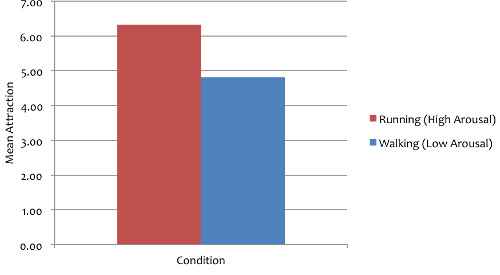The Simple Experiment: Two-group Design
Overview
Source: Laboratories of Gary Lewandowski, Dave Strohmetz, and Natalie Ciarocco—Monmouth University
A two-group design is the simplest way to establish a cause-effect relationship between two variables. This video demonstrates a simple experiment (two-group design). In providing an overview of how a researcher conducts a simple experiment (two-group design), this video shows viewers the process of turning ideas into testable ideas and forming hypothesis, the identification and effect of experiment variables, the formation of experimental conditions and controls, the process of conducting the study, the collection of results, and the consideration their implications. This research technique is demonstration in the context of answering the research question: “How does physiological arousal/excitement influence perceived attraction?”
Procedure
1. Introduction of topic/research question
- Research question: All research seeks to answer questions. Often those questions start out fairly broad (e.g., What leads to attraction?). The researcher then forms a hypothesis based on educated guesses about potential answers.
- Research hypothesis: Those who are experiencing high excitement will see others as more attractive than those who are experiencing low excitement.
2. Key variables
- Variable = anything that changes in a study
- Independent variable = the cause or what the researcher manipulates/changes in order to detect changes in the participant
- Based on the hypothesis, excitement is the independent variable.
- Dependent variable = the effect or the outcome that the researcher measures in the participant.
- Based on the hypothesis, perceived attractiveness is the dependent variable.
3. Defining the variables
- To manipulate the independent variable of excitement, have participants run on a treadmill.
- To measure the dependent variable of perceived attractiveness, show participants pictures.
4. Establishing conditions
- Experimental condition = The group that receives the key ingredient, or whatever the researcher believes will have the most influence on the outcome.
- Ethical consideration: In using a manipulation that requires physical effort such as this, the researcher must be mindful of the pertinent ethical considerations (i.e., people should be in shape and cannot have them run too hard to too long)
- Control condition = The condition that does not have the key ingredient. This group serves as the baseline for comparison.
5. Experimental control
- What it is: Keeping everything exactly identical across conditions except for the key piece that the researcher wants to manipulate/change
- It’s importance: This is the only way a researcher can isolate which piece or factor is responsible for the changes in the dependent variable.
- Application to study: In the present study the researcher wants to focus on how excitement/arousal influences attraction. As such, excitement/arousal should be the only piece that changes between conditions. Thus, if the experimental group (high arousal) runs on a treadmill at 6mph for 3 minutes in a lab, the control group should be as similar as possible. They should be on a treadmill in lab for 3 minutes, but should walk at 3mph.
6. Measuring the dependent variable (attraction)
- Use of pictures
- Key measurement considerations: shouldn’t be too attractive or unattractive, shouldn’t have piercings/tattoos; and should just be head shot
- 7-point Likert Scale: 1 = extremely unattractive; 7 = extremely attractive
7. Procedure/conducting the study
- Informed consent
- Tell participants: “Here is the informed consent, which outlines what the study is basically about, any risks/benefits of participation, and lets you know that you are free to quit at any time.”
- Random assignment to condition
- Randomly order the packets so that the participant’s condition (running or walking) is not based on anything other than chance. Otherwise, the researcher may subconsciously be more likely to assign certain participants (e.g., those who look physically fit) to certain conditions (e.g., running).
- Running the study: Experimental condition
- Set treadmill to 6 mph, explain to the participant what they need to do, and start the timer for 3 min.
- Show participants a series of pictures and ask them to rate on provided scale (1 = not at all attractive through 7 = extremely attractive).
- Running the study: Control condition
- Set treadmill to 3 mph, explain to the participant what they need to do, and start the timer for 3 min.
- Show participants a series of pictures and ask them to rate on provided scale (1 = not at all attractive through 7 = extremely attractive).
- Debriefing
- Explain the purpose of the study to the participant: “Thank you for participating. In this study I was trying to determine if excitement or arousal from exercise would lead participants to find a picture more attractive. To manipulate excitement/arousal there were two conditions; running vs. walking on the treadmill. Do you have any questions?”
Results
After collecting data from 122 people, a t-test for independent means was performed comparing the high arousal (running) condition to the low arousal (walking) condition to see how they influenced attraction. As shown in Figure 1, those in the running/high arousal condition, depicted with the red bar found the pictures more attractive than those in the walking/low arousal condition.
The results of this study are similar to the famous “bridge study” where researchers found that men who crossed a high shaky bridge were more attracted to a female, than other men who crossed a low sturdy bridge.1

Figure 1. Mean Attraction Ratings by Arousal Condition.
Application and Summary
Considering the potential effects of arousal on attraction, it may be better to talk to someone you’re interested in while at the gym, instead of the library. It also suggests that a rock concert may be better first date than a poetry reading.
Skip to...
Videos from this collection:
Copyright © 2025 MyJoVE Corporation. All rights reserved


